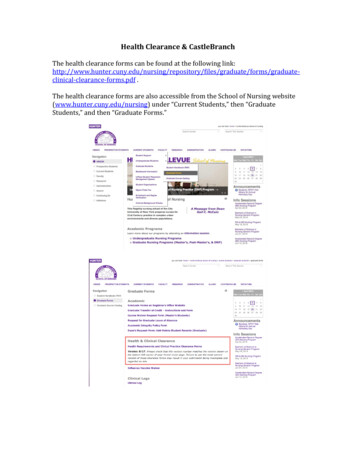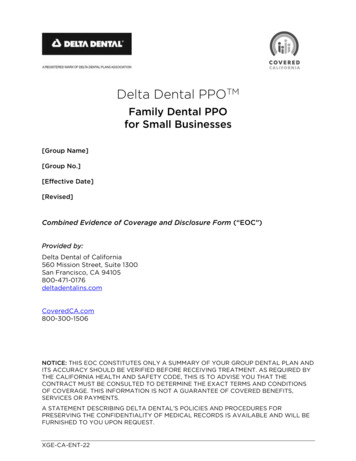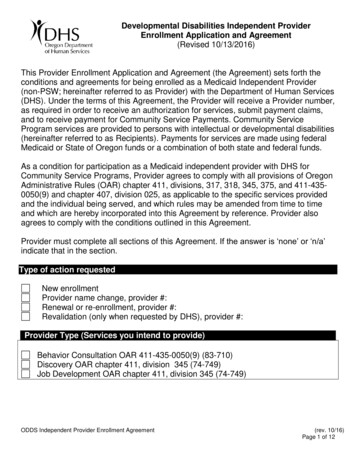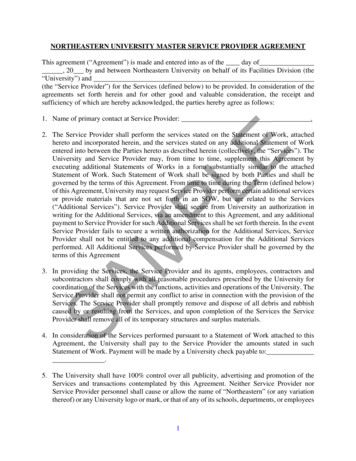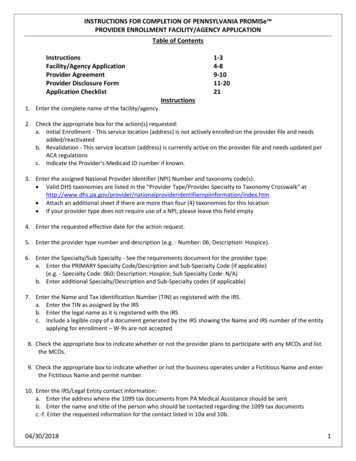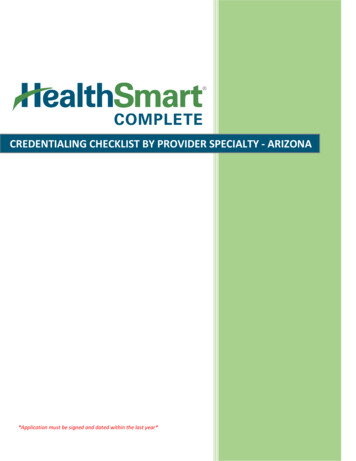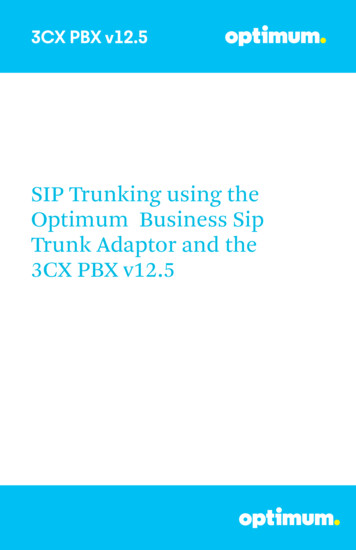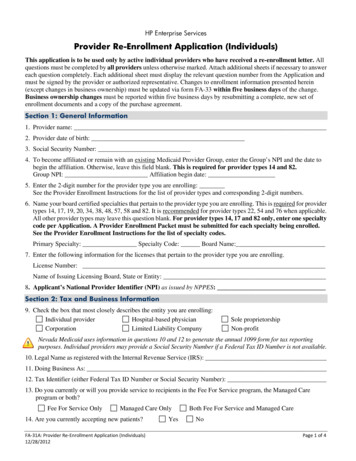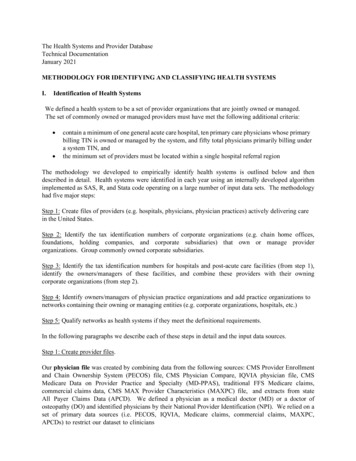
Transcription
The Health Systems and Provider DatabaseTechnical DocumentationJanuary 2021METHODOLOGY FOR IDENTIFYING AND CLASSIFYING HEALTH SYSTEMSI.Identification of Health SystemsWe defined a health system to be a set of provider organizations that are jointly owned or managed.The set of commonly owned or managed providers must have met the following additional criteria: contain a minimum of one general acute care hospital, ten primary care physicians whose primarybilling TIN is owned or managed by the system, and fifty total physicians primarily billing undera system TIN, andthe minimum set of providers must be located within a single hospital referral regionThe methodology we developed to empirically identify health systems is outlined below and thendescribed in detail. Health systems were identified in each year using an internally developed algorithmimplemented as SAS, R, and Stata code operating on a large number of input data sets. The methodologyhad five major steps:Step 1: Create files of providers (e.g. hospitals, physicians, physician practices) actively delivering carein the United States.Step 2: Identify the tax identification numbers of corporate organizations (e.g. chain home offices,foundations, holding companies, and corporate subsidiaries) that own or manage providerorganizations. Group commonly owned corporate subsidiaries.Step 3: Identify the tax identification numbers for hospitals and post-acute care facilities (from step 1),identify the owners/managers of these facilities, and combine these providers with their owningcorporate organizations (from step 2).Step 4: Identify owners/managers of physician practice organizations and add practice organizations tonetworks containing their owning or managing entities (e.g. corporate organizations, hospitals, etc.)Step 5: Qualify networks as health systems if they meet the definitional requirements.In the following paragraphs we describe each of these steps in detail and the input data sources.Step 1: Create provider files.Our physician file was created by combining data from the following sources: CMS Provider Enrollmentand Chain Ownership System (PECOS) file, CMS Physician Compare, IQVIA physician file, CMSMedicare Data on Provider Practice and Specialty (MD-PPAS), traditional FFS Medicare claims,commercial claims data, CMS MAX Provider Characteristics (MAXPC) file, and extracts from stateAll Payer Claims Data (APCD). We defined a physician as a medical doctor (MD) or a doctor ofosteopathy (DO) and identified physicians by their National Provider Identification (NPI). We relied on aset of primary data sources (i.e. PECOS, IQVIA, Medicare claims, commercial claims, MAXPC,APCDs) to restrict our dataset to clinicians
who are delivering care to patients at some point during the year. We used the NPPES to identifyphysicians separately from other clinicians whose NPIs appeared in our primary data sources (e.g. nursepractitioners). Data from the National Plan and Provider Enumeration System (NPPES), MD-PPAS,CMS Physician Compare, IQVIA, and commercial claims were combined to classify specialty for eachphysician. To code physician specialty uniformly, we developed a physician specialty taxonomybased on board certifications offered by the American Board of Medical Specialties (ABMS) andmapped specialty classifications in each of the input data sets to the taxonomy. We then combined allavailable specialty data for each physician and assigned each physician to one of 123 ABMS terminalspecialties (details are available upon request). Physicians were classified as primary care if theirprimary specialty is family practice, general practice, pediatrics, geriatrics, or internal medicine with nomedical or surgical specialty (excluding pediatric subspecialty).We defined a physician practice as a legal entity that is fully or partially owned by physicians (e.g. soleproprietorship, partnership) or that employs physicians actively delivering care. To create the physicianpractice file, we combined data from PECOS, Medicare claims, IQVIA practice site file, andcommercial claims.We used two PECOS files to identify the practice TINs through which physicians submit claims. ThePECOS reassignment file contains observations for every NPI-TIN combination for which the Medicarecertified physician (NPI) has reassigned his or her Medicare benefits (i.e. payments) to a providerorganization (TIN). Physicians may reassign benefits to multiple provider organizations andthese provider organizations may be physician practices (corporations or partnerships), hospitals,other health care facilities, and corporations (e.g. health systems, joint ventures). The PECOSenrollment associations file also contains observations for physician practices and provides informationon their relationships with individuals (e.g. partner) and other organizations (e.g. owning ormanaging entities, billing agencies).Importantly it contains information on practiceorganizations established as sole proprietorships; these organizations are not included in the PECOSreassignment file. We used role codes in the PECOS enrollment associations file to identify thesepractices and to generate NPI-TIN observations. The NPI-TIN observations extracted from these twoPECOS files were then checked against Medicare claims (carrier, outpatient, inpatient, PartD andMDPASS) data, commercial claims, CMS Physician Compare, and the list of physicians who haveopted out of Medicare. Any NPI-TIN observations from PECOS that were billing claims (LCD, Carrier,OP, IP) in a previous year but not the current year were assumed to be inactive in the current year. NPTTIN pairs which do not have any previous claims but are in PECOS were assumed to be valid. In addition,there are NPI-TIN observations present in Medicare claims data that do not have correspondingobservations in any PECOS file; we believe they are missing from PECOS data because theserelationships pre-dated the creation of certain PECOS files, were not required to formally enroll, andhave been grand-fathered into the system. Any TIN observed in Medicare Carrier or LCD claims datathat are not also present in the PECOS data were included as physician practices.IQVIA data does not contain TINs for provider organizations. For each active physician (NPI) inour physician database that is not observed in one of our claims databases, we searched the set of practicesite-NPI combinations in IQVIA data and included the matched practice sites as observations in ourphysician practice database. This screening process allowed us to include physician practices whosemembers are actively serving patients but who do not bill one of the payers from whom we have claimsdata. Most of the physicians observed in IQVIA and not in claims data are pediatricians.We defined an acute care hospital to be a facility with at least 6 beds available for patients receivinginpatient care for acute medical conditions. We drew on three primary data sources to create our short-
term acute care hospital file: CMS provider of services (POS) file, IQVIA hospital file, andAmerican Hospital Association (AHA) survey data. None of these data sources are comprehensiveand each has limitations. In addition, there is no observation ID that is used consistently in all threesources. A couple of limitations are worth noting. The POS file is generated from administrativedata and contains observations on hospitals that are closed or have changed their primary use and nolonger provide acute care services (e.g. hospitals that have converted to post-acute care facilities).We used the hospital ite (https://atlasdata.dartmouth.edu/static/supp research data#hospital-research-data)combined with web-based research to address deficiencies in the CMS POS data. CMS allows multiplehospitals with the same owner to report in consolidated form, as a single entity, under one CMSCertification Number (CCN). All information reported in the POS file with the exception of location(e.g. count of beds, services available) refer to the combined set of hospitals reporting under a singleunique CCN (usually the CCN of the larger hospital); the address listed for each CCN is the address of themain hospital. The AHA similarly allows a “parent” hospital to fill out one survey for the combination ofthe parent and “unit” hospitals. In contrast, IQVIA data contain unique observations for each hospitalfacility but sometimes list units within a hospital (e.g. a pediatric center) as a separate hospital facility.Finally, in each of these hospital datasets, the dominant type of services provided at the hospital (e.g.general acute care, pediatric care, orthopedic surgery, cancer care) is not coded in a comparable fashion.To overcome the limitations of these individual hospital databases, and to ensure that our hospital datawould be comprehensive (i.e. that it would include a unique observation for every short term acute careinpatient facility), we combined data from all three sources using a novel approach. First, becauseaddress was the only comparable field included in all three sources, we geocoded the address of eachfacility included in each hospital database. Second, we grouped observations into location IDs basedon their proximity to one another, taking into account any available cross source references (e.g. AHAreports CCNs for some hospitals) and address string comparisons. Third, we created a new hospitalservice type variable based on the source’s original coding of primary service type and stringsearches of the hospital name. Fourth, within location ID, we combined observations from differentsources with the same hospital service type. Fifth, we manually reviewed cases of multiple hospitalfacilities with the same services type at a given location ID. This set of steps resulted in a hospitalfile containing a unique observation for each inpatient hospital facility located at a unique address andproviding a unique primary service. We created a hospital ID that is consistently coded over time andlinked that to the ID variables in each of the source datasets (e.g. CCN, AHA ID, IQVIA ID). Thevariable for primary service type may take one of the following values: general acute care (medical andsurgical), children’s, psychiatric (includes hospitals treating substance use disorders), heart, women’s,cancer, orthopedic, geriatric, other specialty.We defined post-acute care (PAC) facilities to include skilled nursing facilities, rehabilitationfacilities, home health agencies, and hospice. Because long term acute care facilities are qualitativelydifferent from short term acute care hospitals and may see some of the same types of patients as PACfacilities, we included these providers in the PAC provider file. Data on these facilities was extractedfrom the CMS POS file.Step 2: Identify and Group TINs of Health Care Corporations and their Subsidiaries.Health systems can be defined empirically as sets of TINs that are a mix of provider TINs and corporate(non-provider) TINs. Many large health care systems have a complex corporate organization in which theconstituent provider organizations are owned by corporate subsidiaries which in turn are owned or
governed by a single corporate entity. Most of the TINs in these corporate hierarchies are non-providercorporate TINs.Occasionally, provider organizations have multiple owners (e.g. they are organized as a joint venturecorporation or partially or fully owned by private equity) or affiliations with multiple health carecorporations. Multiple owners and affiliations present special challenges to identifying distinct healthsystems. To avoid combining two or more health systems connected by jointly owned or affiliatedproviders, we began building our health systems with “wholly-owned” TINs. Wholly-owned TINs have asingle owner and can therefore be grouped together to form systems without inadvertently combiningotherwise distinct networks of providers. Health system corporate TINs are typically wholly-owned, butprovider TINs may be jointly owned or have affiliations with multiple health care corporations that aredifficult to distinguish from ownership relationships in PECOS data and other TIN-based datasets.We used a “top-down” empirical strategy to build networks of wholly owned TINs. The first step was toidentify a set of wholly-owned TINs in PECOS data. Chain home offices (CHOs) in PECOS are definedas “[groups] of two or more providers under common ownership or control” (42 CFR 421.404). Based onthis legal definition, we are fairly certain that these entities are wholly-owned. The PECOS Chain HomeOffice Addresses File contains the postal addresses for the PECOS chain home offices. We groupedthe TINs corresponding to Chain Home Offices with the same address into a single network.Academic health systems are another group of wholly-owned TINs. Each school is separately licensed orapproved by the state and has its own board of trustees (U.S. Department of Education, “Organization ofU.S. Education: Tertiary Institutions”). We identified their TINs in PECOS by searching for thewords “College” and “University” in providers’ legal business names. Since this text-based search yieldsproviders that are not part of academic health systems (e.g., the multi-specialty group UniversityPhysicians Group located in New York state), we manually screened for false positives and dropped themfrom our list of TINs. We then grouped TINs by college, university, or university systems and addedthese sets of TINs to the list of chain home office TINs.The second step in creating networks was to combine wholly-owned TINs with the same ownership ormanagerial control. Some of the wholly-owned TINs on our list, particularly the PECOS chain homeoffices, are subsystems that together form a single health system (e.g. Ascension Health and AlexianBrothers Health System). To group wholly-owned TINs we used multiple data sources to create a datasetof TIN-TIN pairs related by common ownership or managerial control. The input data sources for thisTIN-TIN dataset are: PECOS Chain Home Office Addresses File. This file contains the postal addresses for thePECOS chain home offices. Some systems and subsystems list the same address(es), which weexploited to put related organizations in common networks.IRS Business Master File. This file lists related organizations that file a single common tax return.We used these data to group together wholly-owned TINs that are part of the same filings.IRS 990 Filings for Tax-Exempt Entities sourced from both a proprietary data set prepared for usby Guidestar (now Candid) and filings hosted by Amazon Web Services (AWS):o Main Form with “Doing Business As” names and website addresses. We grouped togetherwholly-owned TINs with the same “Doing Business As” names and/or website addresses.o Schedule R with filers’ related organizations and their direct controlling entities. Wegrouped together wholly-owned TINs that appear as filers and/or related organizationswith hospitals and subsidiaries listed in Schedule R filings as directly controlled entities.Based on the definition of related organizations and direct controlling entities, we believe
TIN pairs constructed from this Schedule R data describe ownership and managerialcontrol and do not constitute mere affiliations. We believe the hospitals that appear theseTIN pairs are also wholly-owned entities (because they appear as directly controlledentities of a wholly-owned TIN). Annual SEC10-K Filings. Exhibit 21 lists each filer’s subsidiaries. We used these data, compiledby the non-profit organization CorpWatch, to group together wholly-owned TINs. S&P Capital IQ M&A Transactions. This file contains many consummated M&A Transactionsduring our time period. We used these data to group together wholly-owned TINs and/or takethem apart to correct for time lags in our other data sources. Irving Levin Associates Deal Search Online Database and Health Care Services AcquisitionReports, 2010 - 2018, editions 17 - 25 (www.healthcaremanda.com). These data containannounced M&A Transactions, some of which have been consummated. We identifiedconsummated transactions between wholly-owned TINs on our list and used these data (like theS&P Capital IQ M&A Transactions above) to correct for lags in our other data sources. Hand coding. Through this process, we identified errors in the data that we fixed with hand coding.From these sources we created a single dataset of wholly-owned TIN pairs that are related throughcommon ownership or managerial control relationships. With these pairwise relations, we used R’s igraphpackage to create mutually exclusive groups of TINs. Combining these wholly-owned TINs allowed usto avoid the incorrect combination of corporations linked through joint ventures and other partialownership arrangements. It also helped us combine systems comprised of several subsystems. At the endof this step, we had a file that grouped together wholly owned TINs that are commonly owned or managed.Step 3: Identify TINS for hospitals and PAC facilities and add these providers to networks of owningentities.To add hospitals and post-acute care facilities to the wholly-owned networks created in step 3, we firstidentified the TINs used by these facilities for billing and reporting. In POS data, these facilitiesare identified using CMS Certification Numbers (CCNs). We used data from the PECOS Medicare ID fileto find PECOS enrollment IDs for each facility CCN and then used the PECOS main provider file tolink each enrollment ID to a facility TIN. Hospital and PAC CCNs may be associated with more than oneTIN.The second step was to create a dataset of TIN-TIN pairs that include at least one hospital TIN and wherethe TIN pairs are related by common ownership or managerial control (similar to the file of TIN-TIN pairswe created in step 3 to combine wholly-owned TINs into networks). The input data sources for thishospital TIN-TIN dataset are: IRS 990 Forms sourced from Guidestar (now Candid) and AWS.o Schedule A with filers’ supported organizations. This file contains the supportedorganizations for IRS 990 filers that are 509(a)(3) organizations.o Schedule H with hospital facilities. This file contains the hospital facilities managed andcontrolled by IRS 990 filers who are hospital corporations.o Schedule R with (i) TIN pairs between the IRS 990 filer and its related organizations and(ii) TIN pairs between related organizations and their direct controlling entities. Welimited TIN pairs to those between hospitals as well as those between our list of whollyowned TINs (from Step 3) and hospitals. IRS Business Master File (BMF). A small number of large religious filings not directly connectedto health care delivery organizations (the General Conference of Seventh-day Adventists, theEvangelical Lutheran Church in America, the United States Conference of Catholic Bishops, andthe Baptist
Convention of Texas) are dropped. We limited the IRS BMF extract to observationscontaining TINs of hospitals or wholly-owned chain home office TINS. Annual SEC 10-K Filings. We used these data to group together hospitals that have a commonowner. We limited TIN pairs to those between our list of wholly-owned TINs and hospitals. S&P Capital IQ M&A Transactions. We subset the file for consummated M&A transactionsinvolving hospitals and used these data to correct for lags in other data sources. Irving Levin Associates Deal Search Online Database and Health Care Services AcquisitionReports. We used consummated hospital mergers and acquisitions in the files to correct for timelags in our other data sources. As with many of the other files, we limited TIN pairs to thosebetween our list of wholly-owned TINs and hospitals. PECOS Enrollment Associations File. We used role codes, which describe the relationshipsbetween providers and their managing and owning entities, along with providers’ organizationalstructure (LLC, partnership, etc.) to identify ownership relationships in the data. Hand coding. There is a handful of ownership relationships we do not observe in the data. Wewere able to identify some of them when visually screening our list of TIN pairs. We included theserelationships as inputs to the network algorithm. Networks of Wholly-Owned TINs (from Step 3). Finally, we used these data because we wantedthe hospitals to be linked to one of these networks.In this hospital TIN-TIN dataset, we identified hospital TINs that are linked to two or moredistinct networks of wholly-owned TINs (the output from step 3). It is likely that these hospitals havemultiple owners (e.g. joint ventures). We excluded these hospitals at this stage to avoid combining two ormore networks connected by jointly owned providers (but added them back in at a later stage).Using R’s igraph network library operating on the hospital TIN-TIN dataset and the datasetcontaining networks comprised of wholly-owned TINs, we connected hospital TINs to the networks oftheir owning and managing entities. At this stage we revisited the set of hospital TINs initiallylinked to multiple networks. For hospitals that are jointly owned, we used ownership percentagesfrom the PECOS enrollment association file and online research to assign the hospitals to thenetwork with majority ownership. For jointly owned hospitals that do not have a majority owner (e.g.Centura Health, Duke LifePoint) we created a new network for each set of hospitals with commonmultiple owners.Step 4: Identify the owning and managing entities for physician practice organizations and add thesepractices to networks of owning entities.We identified ownership relationships for physician practices in many of the sources we used to createour list of wholly-owned TINs and the hospital skeleton including: PECOS enrollment associations file,IRS 990s from Guidestar (now Candid) and AWS, BMF data, Annual 10-K Filings, S&P CapitalIQ M&A Transactions, Irving Levin Associates Deal Search Online Database and HealthCare Services Acquisition Reports, and an updated list of academic medical groupsoriginally created by Pete Welch and colleagues (Welch and Bindman 2016).In addition, we conducted analyses in Medicare claims data to identify physician practices billing ashospital outpatient departments. We adapted the algorithm developed by Neprash et al. (JAMA 2015;175(12):1932-39) for identifying physician practices that are financially integrated with hospitals andoperate as hospital outpatient departments (HOPDs). After excluding non-physician NPIs and NPIs thatbill predominantly for inpatient care (e.g. anesthesiologists, critical care specialists), we matchedphysician claims in the Carrier file to claims in the Outpatient file based on a combination of beneficiaryID, service date, procedure code, and/or servicing NPI. Claims were classified as HOP (hospitaloutpatient) claims if: they have a hospital outpatient department place of service code or if a physicianclaim in the
carrier file matches a claim in the outpatient file. For each NPI, we computed the percentage of claimsdelivered in a hospital outpatient setting. For each physician practice TIN containing an NPI billing someportion of their claims as HOP, we computed a measure of how concentrated the NPIs’ HOP claims are ina single hospital, or a set of hospitals owned by the same system. We then classified a physician practiceTIN as integrated with a hospital based on: 1) % of NPIs in the TIN classified as integrated with ahospital, and 2) the concentration of TIN HOP claims in a hospital or hospital system. For TIN-CCN/System pairs for which the above criteria are met, we identified physician practice TIN as financiallyintegrated with the CCN with the plurality of matched claims and the physician practice TIN as being amember of the same system as the hospital (CCN).Analogous to the process outlined in Step 3, we created a dataset of TIN-TIN pairs comprised of aphysician practice TIN and the TIN of the entity that owns or manages the practice. Using R’s igraphnetwork library operating on the physician practice TIN-TIN dataset and the dataset containingnetworks comprised of wholly-owned TINs and hospital TINs, we connected physician practice TINsto the networks of their owning and managing entities.Step 5: Qualify networks as health systems if they meet the definitional requirements.The final step in identifying health systems was to ensure that the set of providers associated with eachnetwork ID meets the minimum criteria for qualifying as a health system.Inclusion of a short term general acute care hospitalWe identified short term general acute care hospitals based on the hospital’s primary service type (seestep 1 for details). Any network containing at least one short-term general acute care hospitals wasdeemed to have met this criterion.Inclusion of at least 10 primary care physicians billing primarily to TINs included in the networkFor each primary care physician, we tabulated the number of Medicare and commercial claims billedthrough each practice TIN. For each network, we then tabulated the number of PCPs that billed aplurality of claims through one of the network’s practice TINs. Any network with at least 10 PCPs billingprimarily to network practice TINs was deemed to have met this criterion.Inclusion of at least 50 total physicians billing primarily to TINs included in the networkFor each physician we tabulated the number of Medicare and commercial claims billed through eachpractice TIN. For each network, we tabulated the total number of physicians that billed a plurality ofclaims through one of the network’s practice TINs. Any network with at least 50 physiciansbilling primarily to network practice TINs was deemed to have met this criterion.Minimum set of providers located within a single hospital referral region (HRR)Each physician practice and hospital was assigned to a HRR based on zip code. Any network withthe minimum set of providers located within a single HRR was qualified as a health system.
II. Classification of Health System into CategoriesFor descriptive analyses, we classified each health system into one of five mutually exclusive categoriesbased on size, and the ownership type and academic mission of the system’s hospitals. Categoryassignment was made sequentially in the order shown below.Assessing hospital ownership and teaching statusThe POS and AHA survey data include a variable to describe the hospital’s ownership. The typesof ownership in each of these databases vary slightly but ownership type is correlated across thesedatabases for the vast majority of hospitals. In cases where there were disagreements acrosssources, we implemented the following rules:1. First default to relying on the POS data.2. If the POS data are missing, “Other,” or “Unknown,” then use the AHA data.3. Define hospital ownership as public when the AHA ownership is one of the following values:“CITY”, “CITY-COUNTY”, “COUNTY”, “STATE”, or “HOSPITAL DISTRICT ORAUTHORITY.”4. Define hospital ownership as non-profit when the AHA hospital ownership is given as“OTHER NOT-FOR-PROFIT” and the POS hospital ownership is “PRIVATE (FORPROFIT).” Upon closer inspection, most of these hospitals appeared to be non-profit as opposedto for-profit and were thus reflected more accurately in the AHA survey data.Assignment of health systems to a category1. Academic Health System. A health system was categorized as academic if it met either of thefollowing criteria: a) total graduate medical education payments to the system’s hospitals exceeds 30,000 per general acute care bed and at least 33% of the system’s general acute care beds are inan AHA major teaching hospital; or b) the system met just one of these criteria but received atleast 25 million dollars in total graduate medical education payments during the calendar year.Data on hospital graduate medical education payments was obtained from HCRIS. A hospital wasclassified as a teaching hospital if it met either of the following criteria: a) the hospital is describedas a major teaching hospital in the American Hospital Association (AHA) data; or b) the hospitalreceives at least 10 million in graduate medical education payments.2. Public Health System. A health system was categorized as public if it met the following criteria:the system is not classified as an academic health system and a plurality of the system’s hospitalbeds are located in publicly owned hospitals.3. Large Not-For-Profit Health System. A health system was classified as large not-for-profit if itmet the following criteria: the system is not classified as academic or public, is comprised of atleast 50 primary care physicians located in a single Hospital Referral Region (HRR) and atleast 100 primary care physicians across all HRRs, and a plurality of the system’s hospital bedsare located in not-for-profit hospitals.4. Large For-Profit Health System. A health system was classified as large for-profit if it metthe following criteria: the system is not classified as academic, public, or large not-forprofit, is comprised of at least 50 primary care physicians located in a single Hospital ReferralRegion (HRR) and at least 100 primary care physicians across all HRRs, and a plurality of thesystem’s hospital beds are located in for-profit hospitals.
For each active physician (NPI) in our physician database that is not observed in one of our claims databases, we searched the set of practice site-NPI combinations in IQVIA data and included the matched practice sites as observations in our physician practice database. This screening process allowed us to include physician practices whose



